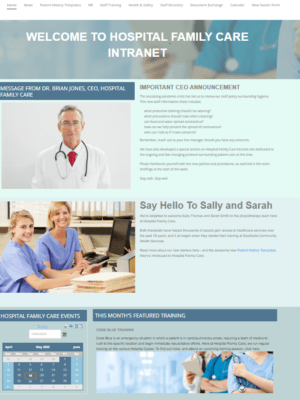Poor knowledge management can have a negative impact on the performance of any organization. However, the effects of poor knowledge management for healthcare teams may well have more serious consequences. Malpractice, misdiagnoses, administering the wrong medication or incorrect dosage are all very real possibilities in an environment where tacit and explicit knowledge are not easily shared. As well as reduced patient outcomes, conflict and dissatisfaction among staff, inadequate knowledge management systems – and associated poor communications – can lead to expensive lawsuits and negligence claims.
When a pandemic is added to the mix – where resources are limited, staff face competing demands, and a medical situation that can change hourly – then improving knowledge management becomes a priority for every healthcare professional. In this article, we offer some practical tips and advice on how to improve this for your healthcare teams.
Knowledge Transfer In Healthcare
Healthcare is delivered in a dynamic and fast-changing environment. Combine this with the number of disciplines involved in caring for a patient and communications become complex and challenging. Patient care is usually delivered and monitored on a departmental basis. And often there are multiple agencies involved. Information silos and poor communication between and across healthcare providers are, therefore, major issues.
In addition, healthcare teams are often understaffed and overloaded with work. Research confirms that as well as increasing staff burnout, stress and job dissatisfaction, this also impacts on how information-sharing occurs.
Poor organizational culture is often at the heart of the communications and knowledge-sharing issue. Lack of training and professional development combined with high staff turnover and inflexible management systems compound the problem.
Furthermore, staff often have insufficient access to technology. The ability to quickly and easily transmit patient data, or access essential processes and know-how, is fundamental to good healthcare communications. Digital solutions can support this process. However, staff can find technology a challenge alongside the priority of maintaining operations.
Effects Of Poor Knowledge Management In Healthcare
According to the 2018 CIRCO Strategies report into medical malpractice in America, around 30 percent of malpractice cases were the result of communication failures and lack of timely information. In the majority of these cases the communication failures were easy fixes. Most of the errors occurred because information was either unrecorded or misdirected. Often data was never received, never retrieved, or was simply ignored.
Unfortunately, the outcomes for patients in many instances were catastrophic. And the consequences for the healthcare provider were expensive in terms of legal costs and also a damaged reputation.
In addition, the impact on staff morale, workplace conflict and productivity as well as recruitment and retention should not be underestimated.
5 Steps To Improve Knowledge Management Within Healthcare Teams
Knowledge management with a healthcare setting is a way for employees to create, learn, share, and leverage intelligence together for the benefit of the organization and its patients. Here are five tips for creating a knowledge-rich environment where staff are encouraged to share their wisdom.

An intranet can incorporate knowledge management tools for healthcare employees
Prioritize Communication As An Essential Part Of Your Organization’s Culture
Review your organization’s existing communications channels and make sure they are still fit for purpose. Use a variety of media to engage your diverse workforce:
- Online newsletters as well as the traditional printed variety
- Corporate and team blogs or forums in which staff can share insights and feedback as well as commenting on and liking content
- Staff suggestion schemes where employees can raise concerns with leaders as well as offering valuable ideas on service improvements
- Implement regular staff satisfaction surveys as well as patient feedback surveys to gather views and feedback. However, make sure you involve staff in developing action plans. And report back on what you have done in response to the survey data
- Incorporate two-way communications channels so staff have opportunities to feedback their views to management as well as receiving top-down messages
- Walk the talk – as a leader making yourself accessible and visible to your employees sets the right tone. As does having an open-door policy
These are just a few suggestions to get you thinking about the potential communications channels in your organization.
In addition, the review needs to look at both internal and external communications. According to Forbes, the cost of poor communications in US hospitals alone is some $12 billion per year. However, these costs are not just down to internal communications failures. Problems exist between healthcare providers as well as inter-departmental communication. Records going missing, unnecessary tests or second opinions being carried out are commonplace. It may be wise, therefore, to look at wider geographical solutions such as a regional healthcare extranet or portal. These solutions ensure data as well as good practice information are securely and efficiently shared across a variety of providers.
Ensure Communications Are Central To Staff Onboarding
All staff need to be meticulously recruited and fully inducted into your organization’s communications processes and technologies. Prioritizing communications within the onboarding process underlines the importance you attach to it as an organization. And it means that staff understand how communications work from the get-go along with the high expectations you have set.
A common gripe from staff is the lack of training or access to technology. Timely communication about a patient’s diagnosis, vital signs and symptoms between medical teams is at the heart of good healthcare. Staff need to be given the time, space and technological tools to get this done as efficiently as possible. And that process starts with effective onboarding.
 Set An Expectation For Regular Team Meetings
Set An Expectation For Regular Team Meetings
There’s nothing quite like face-to-face communication. Difficult though it may be in fast-paced and demanding healthcare settings, team meetings should be a priority. Set regular monthly team meetings at different times to suit shift workers or non-desk personnel. Corporate messages, changes in practice or policy, and lessons from research can be shared up, down and across the organization. In addition, employees can share with each other and management learning and good practice insights. These meetings are also a good forum for discussing patient feedback and any thoughts on areas of improvement. And they provide an opportunity for regular review of working practices and the open exchange of information between colleagues.
Develop Clear Systems For Organizational Learning
Whether you are sharing information between healthcare professionals internally or across providers, make sure you have clear systems in place. Many healthcare teams have developed communications protocols to ensure critical information is relayed quickly and efficiently. Examples include read-back protocols. As the name suggests, this involves repeating back an instruction or important information to ensure it has been clearly understood. Various studies have shown this simple step alone can reduce errors and improve organizational learning.
Another protocol commonly used is the Situation Background Assessment Recommendation (SBAR) approach. SBAR is an effective framework for managing communications. It standardizes the steps that need to be taken and is often used to communicate clinical assessments of patients especially within acute care.
In addition, handoffs and signout protocols have been developed by many healthcare providers. Staff transferring responsibility for a patient provide a ‘handoff’. While a ‘signout’ refers to the information being transmitted about the patient. Without a robust handoff and signout protocol, breakdowns in communication can easily occur. In fact, this area has been linked to a number of adverse clinical events.
Other healthcare providers have set up online checklists and primers as communication tools. Whatever system you end up using, it’s essential to have protocols set up to minimize the potential for errors and mistakes.
Make Use Of Knowledge Management Technology
Technology is increasingly being used to support internal intelligence. Hospitals and healthcare providers are already using online networks, shared drives, and intranets to improve access to data and internal communications.
Most providers have at least invested in some form of electronic health record (EHR). Patient record sharing as well as cross-departmental and provider communications are now much easier than ever before. Once upon a piece of time information would have been shared via printed files or handwritten memos. Nowadays the same information is securely shared electronically both within the organization and with external healthcare partners.
However, the sheer number of EHR systems means these are not always compatible. So, what should be a straightforward process of sharing patient data between providers can be unnecessarily complicated by different systems. Misaligned information or worse still incomplete data can often be the end result.
Streamlined employee workflow is another area that has had a knock-on effect on communications. Online solutions mean that staff can complete one form to, for instance, update all professionals involved in a patient’s care. For example, a nurse records a change in medication on an online form. This is then automatically routed to the practitioners involved for action. What’s more, a system of alerts can be set up to ensure nothing gets missed. Automated processes reduce the incidence of errors and information going missing while also freeing staff from time-consuming admin duties. As a result your healthcare teams will have more time for in-person communication.
Most of these solutions make use of cloud technology. This means information can be accessed anytime and anywhere. All that’s needed is a smartphone or tablet. As well as being a more affordable solution for providers, it’s also easier for staff to access the technology.
However, often these solutions have been developed on an ad hoc basis with little central oversight. And not all of these digital solutions are interconnected or compatible. Double data entry, multiple sign-on, plus the inability to share data across platforms are common complaints. In addition, these platforms don’t always allow for collaboration between healthcare professionals.
Other technological platforms being explored by healthcare providers include mobile apps, AI and chatbots. Pretty much everyone has a cell phone and so it makes sense to use apps as communication platforms. Let’s take the example of healthcare professionals being able to discuss patients via a mobile video chat. Not only does this cut down on administration costs for healthcare providers; it also improves the patient experience with a faster, more responsive service. Similarly, there is potential for using chatbots and AI to triage patients or deal with minor complaints.
How To Recover Good Communications, Post Covid-19
As healthcare units are in recovery mode following Covid-19, the time is right to review your healthcare knowledge management strategy to ensure they are fit for purpose and future-proofed. There’s no doubt that traditional in-person communication channels still have an important role to play in transferring knowledge in healthcare. However, technology can certainly supplement traditional communication channels for more responsive patient care.
The challenge for healthcare providers is to implement platforms that talk to each other. Cloud-based, single-sign on, fully integrated systems that allow for real-time collaboration and instant messaging should be the minimum. In addition, automated workflows along with easy file and data sharing are also essential. Finally, healthcare professionals should look to implement systems that allow for multi-directional conversations, interaction and dialog within and across healthcare providers.
If your healthcare organization is looking to improve its approach to knowledge management, start a free trial today of MyHub’s intranet solution.



 Set An Expectation For Regular Team Meetings
Set An Expectation For Regular Team Meetings





0 Comments